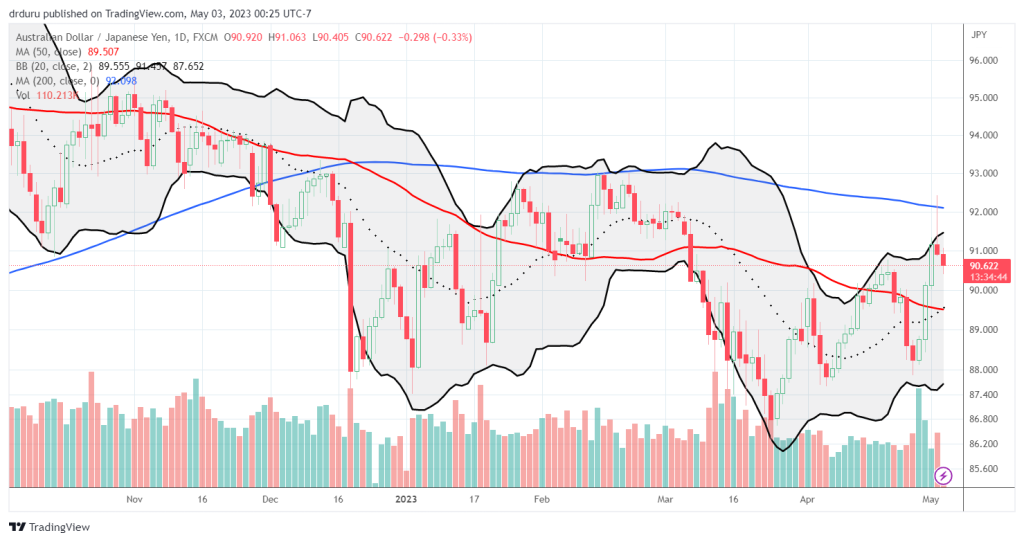Reserve Bank Of Australia Revives The Ghost Of Inflation Past
After the Reserve Bank of Australia (RBA) decided to leave its interest rates unchanged last month, the Australian dollar sold off for a week against the U.S. dollar.

The decline reversed the small rally leading into the decision on monetary policy. AUD/USD enjoyed a small rebound going into the May decision on monetary policy and then jumped after the RBA threw markets for a loop by hiking interest rates again. More importantly, the RBA quickly revived the ghost of inflation past. The RBA undermined any assumptions that it would be content to watch inflation try to guide itself from 7% down to the 2% to 3% target range. The previous pause in rate hikes did not seal the deal on the fight against inflation.
The 15-minute chart of AUD/USD shows how traders rushed to buy in the wake of a surprise rate hike. The enthusiasm peaked within 3 hours. (Source: TradingView)
The RBA acknowledged that “inflation in Australia has passed its peak.” However, inflation at 7% is too high and “…while the recent data showed a welcome decline in inflation, the central forecast remains that it takes a couple of years before inflation returns to the top of the target range.” This inflation horizon means the RBA could intermittently hike rates for quite some time as it scours the landscape for smoldering embers of inflation.
The current problem is in services price inflation. The U.S. also faces this challenge. Indeed, the RBA referenced global commonality in explaining the sources of stubborn highly inflation (emphasis mine):
“Goods price inflation is clearly slowing due to a better balance of supply and demand following the resolution of the pandemic disruptions. But services price inflation is still very high and broadly based and the experience overseas points to upside risks. Unit labor costs are also rising briskly, with productivity growth remaining subdued…Wages growth has picked up in response to the tight labor market and high inflation.”
The RBA further explained that the rate hike should firmly anchor medium-term inflation expectations. Tightening monetary policy is acting like an insurance policy against higher inflation expectations contributing “to larger increases in both prices and wages, especially given the limited spare capacity in the economy and the historically low rate of unemployment.” Unemployment in Australia remains at a 50-year low. Thus, the RBA has plenty of room to continue tightening as needed…at least for now. The RBA acknowledged the challenge ahead in avoiding a recession while it tightens monetary policy: “the path to achieving a soft landing remains a narrow one.”
The RBA concluded the May statement on monetary policy just as it ended the previous statement: “some further tightening of monetary policy may be required to ensure that inflation returns to target in a reasonable timeframe, but that will depend upon how the economy and inflation evolve.” In other words, the market will need to stay on its toes.
The Trade
The intraday surge in AUD/USD was not enough to punch the currency pair through important resistance on the daily level. AUD/USD remains trapped underneath resistance from all three major trendlines: the 20-day moving average (DMA) (dashed line), 50DMA (red line), and the 200DMA (blue line). Thus, I am neutral on AUD/USD until at least after I see how the market responds to the Federal Reserve’s turn to announce monetary policy.
AUD/USD has been stuck in a range for two months. Resistance from the 20DMA, 50DMA, and 200DMA are now capping upside. (Source: TradingView)
The Australian dollar versus the Japanese yen (AUD/JPY) is much more interesting, especially with the Australian dollar holding a significant yield advantage. The Japanese yen is suffering a fresh bout of weakness because the new governor of the Bank of Japan confirmed that he has little interest in tightening policy from ultra low rates. The double dose of yen weakness and Australian dollar strength hurled AUD/JPY right into overhead resistance at the 200DMA. A rush to the “safety” of the yen in the wake of fresh selling in the U.S.’s regional banks help send AUD/JPY in reverse. Still, while the 200DMA held as resistance, AUD/JPY is now making higher highs and higher lows with the 20DMA in an uptrend. The current 50DMA breakout could hold given this fresh momentum. (Recall that a bullish AUD/JPY has bullish implications for the stock market).
Overall, with the RBA on a path that could include higher rates for some time, I like buying the Australian dollar on dips on the assumption it has likely bottomed against the U.S. dollar and the Japanese yen. I am currently (re)accumulating AUD/JPY on this pullback in anticipation of an eventual retest of 200DMA resistance.
AUD/JPY has traded in a well-defined range all year. The latest uptrend is the latest opportunity to build enough momentum to break out. (Source: TradingView)
Be careful out there!
More By This Author:
A Golden Inflation Conundrum
Don’t Blame The Fed: The Fed Gives Us What We Want
An Inflation Downtrend Quickly Evaporates






